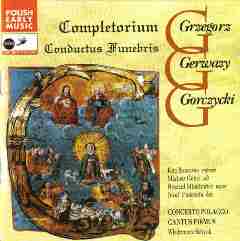Grzegorz Gorczycki - Completorium, Conductus funebris (1994)
Grzegorz Gorczycki - Completorium, Conductus funebris (1994)

Completorium:
1.Cum invocarem
2.In te, Domine, speravi
3.Qui habitat in adiutorio
4.Ecce nunc benedicite
5.Te lucis ante terminum
6.In manus tuas
7.Nunc dimitis
Conductus funebris:
8.Sonata
9.Subvenite Sancti Dei
10.Suscipientes Animam Eius
11.Offerentes Eam
12.Suscipiat Te
13.Suscipientes Animam Eius
14.Requiem Aeternam
15.Offerentes Eam
16.Sonata
17.Libera me Domine
18.Quando Coeli
19.Dum Veneris
20.Tremens Factus SumIn paradisum
21.Quando Coeli
Kira Boryczko – soprano
Mariusz Gebel – alto
Ryszard Minkiewicz – tenor
Józef Frakstein - bass
Concerto Polacco
Cantus Firmus
Włodzimierz Sołtysik – conductor
The first and richest strand of Gorczycki's work is represented by four-parts compositions for mixed choir a capella or with the accompaniment of a small instrumental ensemble (2 Violini, Organo). These are usually in the Palestrinian tradition, prima practica. This style, characteristic of the Polish Baroque, bore a relation to the Renaissance in the sense of the expression of a certain stylization. Gorczycki revealed himself as a pastmaster with a thorough grounding in the counterpointing technique. His masses, his arrangements of the antiphons, hymns, introits, offertories belong to this category. His cantus firmus technique was marked by a striking originality. This fixed tune is taken from the plainchant although it may also come from popular religious songs. We find here a whole gamut of polyphonic devices. The finest works in this form are his Missa paschalis, Sepulto Domino and Tota pulchra es Maria. Post-war research added six formerly unknown compositions to the list.
The second strand of Gorczycki's output are vocal-instrumental compositions in the then current concertante style. The motet Illuxit sol has some features of that style, but it is seen in its full flower in the concertante pieces discovered in the post war years: Laetatus sum, In virtute tua, Litaniae de Providentia Divina, Conductus funebris and Completorium.
Music for instruments forms the third strand of Gorczycki's work. Though modest in scope, it is a documented fact. In 1962 Jan Prosnak published information about a new composition by Gorczycki that had been discovered recently, namely the Ball Polonaise. Regrettably, only the violin part has been found, now carefully preserved in the Jelski family archives. However, it is known that a Polonaise for instruments by Gorczycki was performed by the entire orchestra at Marshal Rokicki's residence at Horodyszcze. This is the first known report of a secular and purely instrumental piece by the composer. But, in view of his achievements in religious music, this seemed highly improbable. However, the catalogue of the Wieluń Piarists published a year later confirmed the fact. It appears that the orchestra of Wieluń also had Gorczycki's Ouverture ex D in its repertory.
Thus, in the light of the research and discoveries made in archives, Gorczycki reveals himself not only as a master composer but also a highly versatile artist who deliberately chose to write conservative polyphonic and a capella pieces although he was highly proficient in the Baroque concerto style of his time and did not shun writing music for instruments.
The assertions of 19th century researchers about his music dramas and songs is finding strong confirmation. He is revealing himself as a towering figure in vocal music a capella, as well as in concertante, vocal and instrumental compositions. For this reason Grzegorz Gerwazy Gorczycki should be hailed today as one of the best composers of Early Polish Music." --- completorium.republika.pl
download: uploaded solidfiles anonfiles yandex 4shared mediafire mega filecloudio








